Exchange Currency
Pakistan rupee
The Pakistani rupee is the official currency of Pakistan. The issuance of the currency is controlled by the State Bank of Pakistan, the central bank of the country.
The most commonly used symbol for the rupee is Rs, used on receipts when purchasing goods and services. In Pakistan, the rupee is referred to as the "rupees", "rupaya" or "rupaye". As standard in Pakistani English, large values of rupees are counted in terms of thousands, lakh (100 thousand, in digits 100,000) and crore (10 million, in digits 10,000,000).
Northern Pakistan fell under Islamic rule during the reign of Mahmud of Ghazna (997-1030). The Ghaznavid Dynasty issued coins with Arabic on one side and Indian Nagari cript on the other. The Ghurids ruled Pakistan from 1150 to 1203 when the Delhi Sultans established their rule over Pakistan. The Mughals conquered Pakistan in 1526 when Babur, defeated the Sultan of Delhi. During the 1750s Pakistan was seized from the Mughals by the Afghans under the first Durrani king, Ahmad Shah (1747-73). The British occupied Bakkhar in 1843 and from then on, Pakistan was under British control. On November 1, 1858 the British government took over the rule of India from the British East India Company. Pakistan gained its independence from British India on August 14, 1947, and East Pakistan declared its independence as the Peoples Republic of Bangladesh on December 16, 1971.
The British tried to bring some order to the monetary chaos as they consolidated their control over India. The British standardized the silver Rupee (INR) throughout India, and made it divisible into 16 Annas, 64 Pice or 192 Pie. It took 15 Rupees to get 1 Mohur. Its value fluctuated, relative to the British Pound, as the values of silver and gold fluctuated. The Treasury of the Government of India issued banknotes until 1943. The Reserve Bank of India was set up in April 1, 1935 and took over responsibility for issuing banknotes.
The East India Company made the Madras rupee of the weight established in 1818 the standard for all of India; it was therefore called the "Company's rupee." Calcutta (sicca) rupees ceased to be legal tender as of January 1, 1838 (East India Company, Act No. 13 of 1836). The 1835 act also provided for coining the gold mohur, which was done beginning September 1, 1835. East India Company, proclamation of January 13, 1841, explicitly allowed mohurs to be used in paying the government, though they were not legal tender for paying private persons. The effect was to make India quasi bimetallic at a ratio of 15 units silver =1 unit gold. Gold mohurs ceased to be legal tender on December 1, 1853 putting India on a silver standard. In 1862 the coinage was transferred from the East India Company to the Indian colonial government (India, Act No. 13 of 1862). In 1876, the government of India was allowed to admit coins of native states as legal tender upon certain conditions (India, Act No. 9 of 1876).
The British standardized the silver Rupee (INR) throughout India, and it became the principal medium of exchange. Its value fluctuated, relative to the British Pound, as the values of silver and gold fluctuated. The Rupee fluctuated between 27 pence in 1870 and 16 pence on June 26 1893 when India effectively went on the gold standard. The Indian Coinage and Paper Currency Act, No. 22 of 1899 established a Pound Sterling exchange standard, giving legal tender status to British Gold Sovereigns. Banknotes were issued by the Government of India from 1861 until 1937, and by the Reserve Bank of India from 1937 until 1948.
The Pakistan Rupee was introduced on April 1, 1948 at par with the Indian Rupee. The Pakistan Rupee was divided into 16 Annas until 1961 and 100 Paisa from 1961 on. The State Bank of Pakistan and the Pakistan Government issue banknotes.
Like the Indian rupee, it was originally divided into 16 annas, each of 4 pice or 12 pie. The currency was decimalised on 1 January 1961, with the rupee subdivided into 100 pice, renamed (in English) paise (singular paisa) later the same year. However, coins denominated in paise have not been issued since 1994.
Regular government issues commenced in 1948 in denominations of 1, 5, 10 and 100 rupees. The government continued to issue 1 rupee notes until the 1980s but other note issuing was taken over by the State Bank in 1953, when 2, 5, 10 and 100 rupees notes were issued. Only a few 2 rupees notes were issued. 50 rupees notes were added in 1957, with 2 rupees notes reintroduced in 1985. In 1986, 500 rupees notes were introduced, followed by 1000 rupees the next year. 2 and 5 rupees notes were replaced by coins in 1998 and 2002. 20 rupee notes were added in 2005, followed by 5000 rupees in 2006.
All banknotes other than the 1 and 2 rupees feature a portrait of Muhammad Ali Jinnah on the obverse along with writing in Urdu. The reverses of the banknotes vary in design and have English text. The only Urdu text found on the reverse is the Urdu translation of the Prophetic Hadith, "Seeking honest livelihood is worship of God", which is حصول رزق حلال عبادت ہے (Hasool-e-Rizq-e-Halal Ibaadat hai).
The banknotes vary in size and colour, with larger denominations being longer than smaller ones. All contain multiple colours. However, each denomination does have one colour which predominates. All banknotes feature a watermark for security purposes. On the larger denomination notes, the watermark is a picture of Jinnah, while on smaller notes, it is a crescent and star. Different types of security threads are also present in each banknote.
The most commonly used symbol for the rupee is Rs, used on receipts when purchasing goods and services. In Pakistan, the rupee is referred to as the "rupees", "rupaya" or "rupaye". As standard in Pakistani English, large values of rupees are counted in terms of thousands, lakh (100 thousand, in digits 100,000) and crore (10 million, in digits 10,000,000).
Summary info
Summary information about Pakistani rupee- ISO 4217 Code:
- PKR
- Currency sign:
- Rs
- Country:
- Pakistan, Afghanistan
- Subunit:
- paisa
- Coins:
- 1 rupee, 2 rupees
- Banknotes:
- 5 rupees, 10 rupees, 20 rupees, 50 rupees, 100 rupees, 500 rupees, 1000 rupees, 5000 rupees
- Central bank:
- State Bank of Pakistan
History
Historically, most coins issued in Pakistan have reflected the coins of its Afghan and Indian neighbors. Afghani silver bent-bar coins were issued in the fourth century BC and Indian punch-marked silver and cast-copper coins were issued in the second century BC. The Scythians, Parthians and Kushans also issued Greek-style coins between the second century BC and the Sasanian Conquest in AD 224. The Huns replaced the Sasanians in the fourth century, and the Turks replaced the Huns in the seventh century.Northern Pakistan fell under Islamic rule during the reign of Mahmud of Ghazna (997-1030). The Ghaznavid Dynasty issued coins with Arabic on one side and Indian Nagari cript on the other. The Ghurids ruled Pakistan from 1150 to 1203 when the Delhi Sultans established their rule over Pakistan. The Mughals conquered Pakistan in 1526 when Babur, defeated the Sultan of Delhi. During the 1750s Pakistan was seized from the Mughals by the Afghans under the first Durrani king, Ahmad Shah (1747-73). The British occupied Bakkhar in 1843 and from then on, Pakistan was under British control. On November 1, 1858 the British government took over the rule of India from the British East India Company. Pakistan gained its independence from British India on August 14, 1947, and East Pakistan declared its independence as the Peoples Republic of Bangladesh on December 16, 1971.
The British tried to bring some order to the monetary chaos as they consolidated their control over India. The British standardized the silver Rupee (INR) throughout India, and made it divisible into 16 Annas, 64 Pice or 192 Pie. It took 15 Rupees to get 1 Mohur. Its value fluctuated, relative to the British Pound, as the values of silver and gold fluctuated. The Treasury of the Government of India issued banknotes until 1943. The Reserve Bank of India was set up in April 1, 1935 and took over responsibility for issuing banknotes.
The East India Company made the Madras rupee of the weight established in 1818 the standard for all of India; it was therefore called the "Company's rupee." Calcutta (sicca) rupees ceased to be legal tender as of January 1, 1838 (East India Company, Act No. 13 of 1836). The 1835 act also provided for coining the gold mohur, which was done beginning September 1, 1835. East India Company, proclamation of January 13, 1841, explicitly allowed mohurs to be used in paying the government, though they were not legal tender for paying private persons. The effect was to make India quasi bimetallic at a ratio of 15 units silver =1 unit gold. Gold mohurs ceased to be legal tender on December 1, 1853 putting India on a silver standard. In 1862 the coinage was transferred from the East India Company to the Indian colonial government (India, Act No. 13 of 1862). In 1876, the government of India was allowed to admit coins of native states as legal tender upon certain conditions (India, Act No. 9 of 1876).
The British standardized the silver Rupee (INR) throughout India, and it became the principal medium of exchange. Its value fluctuated, relative to the British Pound, as the values of silver and gold fluctuated. The Rupee fluctuated between 27 pence in 1870 and 16 pence on June 26 1893 when India effectively went on the gold standard. The Indian Coinage and Paper Currency Act, No. 22 of 1899 established a Pound Sterling exchange standard, giving legal tender status to British Gold Sovereigns. Banknotes were issued by the Government of India from 1861 until 1937, and by the Reserve Bank of India from 1937 until 1948.
The Pakistan Rupee was introduced on April 1, 1948 at par with the Indian Rupee. The Pakistan Rupee was divided into 16 Annas until 1961 and 100 Paisa from 1961 on. The State Bank of Pakistan and the Pakistan Government issue banknotes.
Like the Indian rupee, it was originally divided into 16 annas, each of 4 pice or 12 pie. The currency was decimalised on 1 January 1961, with the rupee subdivided into 100 pice, renamed (in English) paise (singular paisa) later the same year. However, coins denominated in paise have not been issued since 1994.
Coins
In 1948, coins were introduced in denominations of 1 pice, ½, 1 and 2 annas, ¼, ½ and 1 rupee. 1 pie coins were added in 1951. In 1961, coins for 1, 5 and 10 pice were issued, followed later the same year by 1 paisa, 5 and 10 paise coins. In 1963, 10 and 25 paise coins were introduced, followed by 2 paise the next year. 1 rupee coins were reintroduced in 1979, followed by 2 rupees in 1998 and 5 rupees in 2002. 2 paise coins were last minted in 1976, with 1 paisa coins ceasing production in 1979. The 5, 10, 25 and 50 paise all ceased production in 1994. There are two variations of 2 rupee coins; most have clouds above the Badshahi Masjid but many don't have. This is noted by very few people. The one and two rupee coins were changed to aluminium in 2007.Banknotes
On 1 April 1948, provisional notes were issued by the Reserve Bank of India and the Government of India on behalf of the Government of Pakistan, for use exclusively within Pakistan, without the possibility of redemption in India. Printed by the India Security Press in Nashik, these notes consist of Indian note plates engraved (not overprinted) with the words GOVERNMENT OF PAKISTAN in English and “Hukumat-e-Pakistan” in Urdu added at the top and bottom, respectively, of the watermark area on the front only; the signatures on these notes remain those of Indian banking and finance officials.Regular government issues commenced in 1948 in denominations of 1, 5, 10 and 100 rupees. The government continued to issue 1 rupee notes until the 1980s but other note issuing was taken over by the State Bank in 1953, when 2, 5, 10 and 100 rupees notes were issued. Only a few 2 rupees notes were issued. 50 rupees notes were added in 1957, with 2 rupees notes reintroduced in 1985. In 1986, 500 rupees notes were introduced, followed by 1000 rupees the next year. 2 and 5 rupees notes were replaced by coins in 1998 and 2002. 20 rupee notes were added in 2005, followed by 5000 rupees in 2006.
All banknotes other than the 1 and 2 rupees feature a portrait of Muhammad Ali Jinnah on the obverse along with writing in Urdu. The reverses of the banknotes vary in design and have English text. The only Urdu text found on the reverse is the Urdu translation of the Prophetic Hadith, "Seeking honest livelihood is worship of God", which is حصول رزق حلال عبادت ہے (Hasool-e-Rizq-e-Halal Ibaadat hai).
The banknotes vary in size and colour, with larger denominations being longer than smaller ones. All contain multiple colours. However, each denomination does have one colour which predominates. All banknotes feature a watermark for security purposes. On the larger denomination notes, the watermark is a picture of Jinnah, while on smaller notes, it is a crescent and star. Different types of security threads are also present in each banknote.
PKR banknotes pictures gallery
| 5 Pakistani rupees | |
|---|---|
| Banknote of 5 Pakistani rupees has dimensions 115×65 mm and main colors are umber, dim gray, gray, light mauve, dark pastel blue, carolina blue, wild blue yonder, magnolia and gainsboro. The banknote of 5 Pakistani rupees was issued in 2008. | |
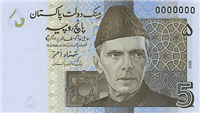 Obverse side of the 5 Pakistani rupees is showing the portrait of Quaid-e-Azam Muhammad Ali Jinnah (25 December 1876 – 11 September 1948). |
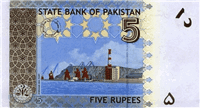 Reverse side of the 5 Pakistani rupees is showing the Gwadar port, which is a mega project in Balochistan (Pakistan). |
| 10 Pakistani rupees | |
|---|---|
| Banknote of 10 Pakistani rupees has dimensions 115×65 mm and main colors are tea rose, timberwolf, pale silver, field drab, pastel brown, olive drab #7, shadow and mint cream. The banknote of 10 Pakistani rupees was issued in 2011. | |
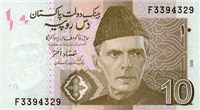 Obverse side of the 10 Pakistani rupees is showing the portrait of Quaid-e-Azam Muhammad Ali Jinnah (25 December 1876 – 11 September 1948). |
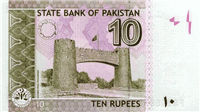 Reverse side of the 10 Pakistani rupees is showing the Khyber Pass Gateway (Bab e Khyber; Bab-al-Khyber; Bab-el-Khyber) on Jamrud Road in Yaghistan near Peshawar. State Bank seal. |
| 20 Pakistani rupees | |
|---|---|
| Banknote of 20 Pakistani rupees has dimensions 123×65 mm and main colors are pale copper, terra cotta, pale gold, banana mania, pale carmine, rose vale, cordovan, lemon chiffon and cornsilk. The banknote of 20 Pakistani rupees was issued in 2011. | |
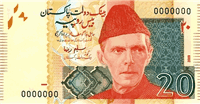 Obverse side of the 20 Pakistani rupees is showing the effigy of the Quaid-e-Azam Muhammad Ali Jinnah (25 December 1876 – 11 September 1948) in National Dress i.e. Sherwani. |
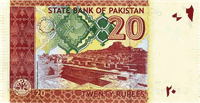 Reverse side of the 20 Pakistani rupees is showing Mohenjo-daro in Larkana District |
| 50 Pakistani rupees | |
|---|---|
| Banknote of 50 Pakistani rupees has dimensions 131×65 mm and main colors are slate gray, dark raspberry, desert sand, mountbatten pink, old lavender, charcoal, liver and pale pink. The banknote of 50 Pakistani rupees was issued in 2011. | |
 Obverse side of the 50 Pakistani rupees is showing the effigy of the Quaid-e-Azam Muhammad Ali Jinnah (25 December 1876 – 11 September 1948) in National Dress i.e. Sherwani. |
 Reverse side of the 50 Pakistani rupees is showing Karakoram Peak (8611 m) of Himalaya mountains and State Bank seal. |
| 100 Pakistani rupees | |
|---|---|
| Banknote of 100 Pakistani rupees has dimensions 139×65 mm and main colors are rose vale, raspberry rose, pastel purple, pale chestnut, grullo, antique brass, pearl and isabelline. The banknote of 100 Pakistani rupees was issued in 2011. | |
 Obverse side of the 100 Pakistani rupees is showing the effigy of the Quaid-e-Azam Muhammad Ali Jinnah (25 December 1876 – 11 September 1948) in National Dress i.e. Sherwani. |
 Reverse side of the 100 Pakistani rupees is showing Quaid-e-Azam Residency in Ziarat. |
| 500 Pakistani rupees | |
|---|---|
| Banknote of 500 Pakistani rupees has dimensions 147×65 mm and main colors are linen, charcoal, dark jungle green, feldgrau, xanadu, grullo, moccasin, almond, light slate gray and pearl. The banknote of 500 Pakistani rupees was issued in 2011. | |
 Obverse side of the 500 Pakistani rupees is showing the effigy of the Quaid-e-Azam Muhammad Ali Jinnah (25 December 1876 – 11 September 1948) in National Dress i.e. Sherwani and Flag of Pakistan in Optically Variable Ink (OVI). |
 Reverse side of the 500 Pakistani rupees is showing Badshahi Mosque in Lahore and State Bank seal. |
| 1000 Pakistani rupees | |
|---|---|
| Banknote of 1000 Pakistani rupees has dimensions 155×65 mm and main colors are dark slate blue, wild blue yonder, ash grey, aurometalsaurus, medium jungle green, light cyan, bubbles, dim gray and splashed white. The banknote of 1000 Pakistani rupees was issued in 2011. | |
 Obverse side of the 1000 Pakistani rupees is showing the effigy of the Quaid-e-Azam Muhammad Ali Jinnah (25 December 1876 – 11 September 1948) in National Dress i.e. Sherwani and Flag of Pakistan in Optically Variable Ink (OVI). |
 Reverse side of the 1000 Pakistani rupees is showing the Islamia college, Peshawar and State Bank seal. |
| 5000 Pakistani rupees | |
|---|---|
| Banknote of 5000 Pakistani rupees has dimensions 163×65 mm and main colors are tan, deep chestnut, russet, dark tan, shadow, cordovan, pale gold, pearl, old lace and moccasin. The banknote of 5000 Pakistani rupees was issued in 2008. | |
 Obverse side of the 5000 Pakistani rupees is showing the effigy of the Quaid-e-Azam Muhammad Ali Jinnah (25 December 1876 – 11 September 1948) in National Dress i.e. Sherwani and Flag of Pakistan in Optically Variable Ink (OVI). |
 Reverse side of the 5000 Pakistani rupees is showing the Faisal Masjid in Islamabad. |
Useful links
- About State Bank of Pakistan:
- State Bank of Pakistan
- List of currencies:
- Currencies
- Security and design features of PKR banknotes:
- PKR banknotes
- PKR currency on Wikipedia:
- Pakistani rupee
- Official Website of State Bank of Pakistan:
- www.sbp.org.pk
- Commemorative coins:
- Commemorative Coins